Origin and Evolution of Quesadillas
Quesadillas, a beloved culinary creation, trace their roots to the vibrant land of Mexico. While their exact birthplace remains shrouded in mystery, the northern regions, particularly Sonora, are widely believed to be the birthplace of this delectable dish.
Initially, quesadillas were crafted with a simple yet satisfying combination of a tortilla and cheese. Over time, as cultures intertwined and culinary traditions evolved, quesadillas embraced a wider array of ingredients, reflecting the rich tapestry of Mexican cuisine.
The Quesadilla’s Journey Beyond Mexico
From its humble beginnings in Mexico, the quesadilla embarked on a culinary odyssey, captivating taste buds far beyond its borders. Its versatility and adaptability made it a welcome guest in kitchens and restaurants worldwide.
In the United States, quesadillas found a particularly warm reception, becoming a staple in Tex-Mex cuisine. They also gained popularity in other regions, with variations emerging to suit local preferences and culinary styles.
The Essence of a Quesadilla
At its core, a quesadilla remains a testament to the simplicity and brilliance of Mexican cuisine. Its defining characteristic is a tortilla, typically made from corn or wheat, folded in half and filled with a delectable array of ingredients.
Cheese, the quintessential ingredient, provides the gooey, flavorful heart of a quesadilla. Oaxaca cheese, with its stringy texture and mild flavor, is a traditional favorite. Monterey Jack, with its creamy and slightly tangy notes, is another popular choice.
Beyond cheese, quesadillas welcome a myriad of fillings, allowing for endless customization. Meats, such as shredded chicken, seasoned beef, or succulent pork, add a savory dimension. Vegetables, like sautéed onions, crisp bell peppers, and juicy tomatoes, provide a vibrant crunch and freshness.
Cooking the Perfect Quesadilla
Crafting the perfect quesadilla requires a delicate balance of heat and precision. Traditionally, quesadillas are cooked on a comal, a flat griddle, or a large skillet. A thin layer of oil ensures a golden-brown exterior while allowing the cheese to melt and bubble.
Once the tortilla is heated, the fillings are carefully placed inside. The quesadilla is then folded in half and cooked until the cheese is melted and the tortilla is crispy.
Serving and Enjoying Quesadillas
Quesadillas are a versatile dish, equally delightful as an appetizer, main course, or late-night snack. They can be served with a variety of accompaniments, such as guacamole, salsa, sour cream, and pico de gallo.
Whether enjoyed at a bustling street stall in Mexico, a cozy restaurant, or in the comfort of one’s own home, quesadillas offer a taste of culinary adventure and the warmth of Mexican tradition.
Other Ingredients Used in Quesadillas
Other ingredients from the wide range of foods found in Mexican cuisine have made their way into the classic quesadilla in addition to meat and cheese, including:
- Cooked beans
- Epazote
- Chicharron
- Salsas
- Harvest vegetables
The Aztecs were already accustomed to harvesting various foods and utilizing tortillas as a vehicle for them. The Aztec communities were adept at managing agriculture in a wide range of climates, from arid plains to jungles, and they produced and consumed a large number of vegetables. It is known that the Aztecs farmed and consumed squash, which they cooked and mashed into a pastry-like consistency. Subsequently, they would fill corn tortillas to the brim and bake them in clay ovens to prepare them as sweeter dishes.
The Mexican quesadilla would be filled and then cooked on a comal, which is a smooth, flat griddle, until the tortilla was slightly crispy and the Oaxaca cheese melted.
By examining a traditional meat and cheese quesadilla piece by piece, we can see that it has always been a multicultural dish because of the contributions of Mexican Native Americans, Italian monks, Spanish explorers, and Native Americans from North America. These days, quesadillas can be found on menus all over the world, but particularly in the American Southwest.
The quesadilla has many variations across the nation for any type of meal. A common choice is the breakfast quesadilla, which consists of a tortilla and a fried egg with avocado. The fillings can also change for people on different diets; for example, a vegetarian may prefer to have tofu or spicy black beans, while others may prefer steak or seafood. When there’s melt cheese to keep it together, anything really can fit in the space left by a folded tortilla!
Backyard Taco offers a variety of quesadilla options on our menu. You can satisfy your craving for a traditional quesadilla with just Monterey Jack cheese, but we also offer our mouthwatering al pastor and shredded beef, paired with red onion and cilantro, creating a flavorful combination that will make your soul happy from the very first bite.

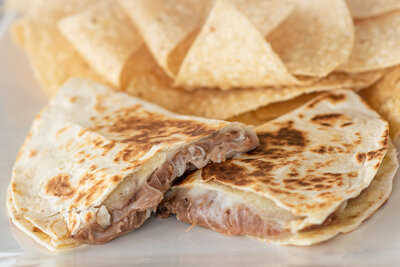
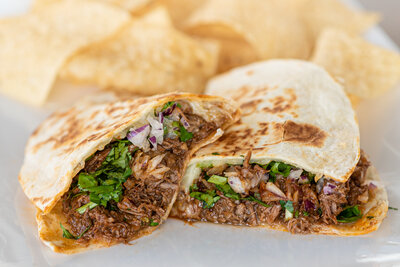
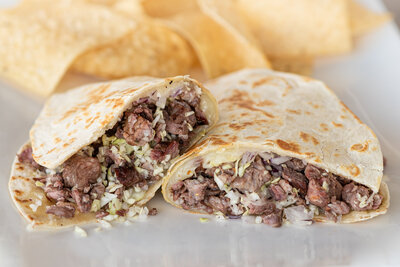
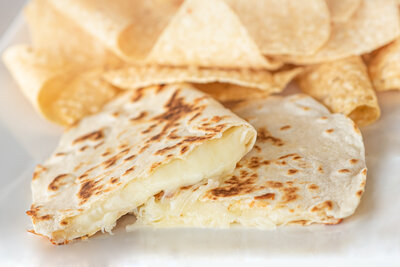
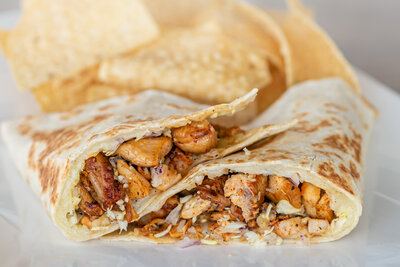
Where Did the Quesadilla Originate?
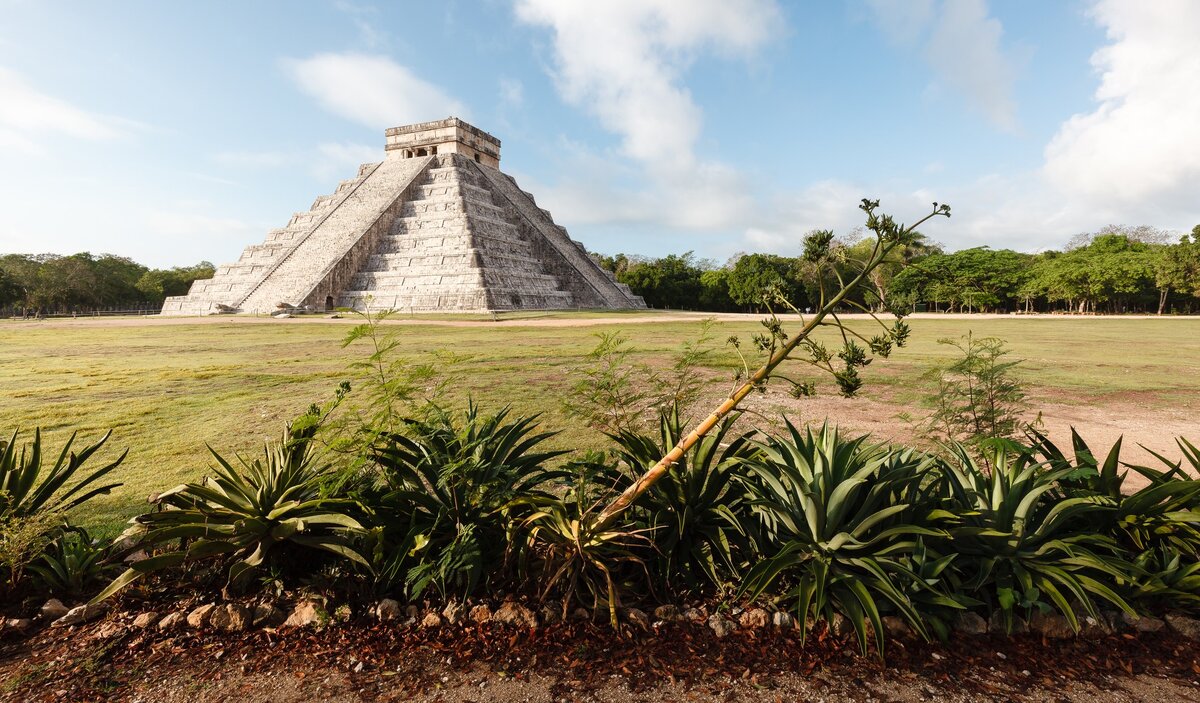 The quesadilla found its long-lasting place in the kitchens of humanity in colonial Mexico. Many believe that the quesadilla was brought to the West by Spain, but after deeply reaching the topic, we can confidently say this is not the case. The most authentic Mexican quesadilla originated in the south-central regions of the Mexico!
The quesadilla found its long-lasting place in the kitchens of humanity in colonial Mexico. Many believe that the quesadilla was brought to the West by Spain, but after deeply reaching the topic, we can confidently say this is not the case. The most authentic Mexican quesadilla originated in the south-central regions of the Mexico!
Let us examine the ingredients of real quesadillas and discuss how various cultural influences came together to create the now-famous dish that people love to eat all over the world.
The tortilla, which is a cooked flat circle of corn masa, would be warmed up and made sufficiently pliable to be folded up. The word itself means “little cake. The first people to eat corn tortillas are thought to have been Native Americans in pre-Columbian times. They were skilled farmers, particularly when it came to cultivating and harvesting maize.
Over time, the flour tortilla gained a lot of popularity in Mexican cuisine dishes like quesadillas. Though made with wheat flour instead of corn flour, flour tortillas are modeled after corn tortillas. For a long while, there was no denying the popularity of corn tortillas, but as wheat became a more widely harvested crop, flour tortillas gained popularity.
The incredibly valuable pocket that is created when the tortilla folds serves as a conduit for the additional ingredients that will be added to it. The Oaxaca cheese that fills these classic masa tortillas is quite similar to the Monterey Jack cheese found in the quesadillas on our menu. Oaxaca cheese is stringy, semi-hard, and white. It melts and has a texture similar to that of mozzarella. Curd-stringing is the method used to make this cheese, and it was brought to Mexico by Dominican monks.
Spain started introducing beef and pork to the indigenous people as early as the 1500s. Meat was not nearly as common in Latin American diets prior to the conquistadors and other explorers as it is now. Different meats would have eventually joined the Oaxaca cheese, even though it was not a common practice in Mexican culture earlier.
Fried Quesadillas, Mexico City-Style
FAQ
Did quesadillas come from Mexico?
Are quesadillas from Mexico or Spain?
What do quesadillas look like in Mexico?
Is quesadilla an Aztec word?
What is a Mexican quesadilla?
A quesadilla ( / ˌkeɪsəˈdiːjə /; Spanish: [kesaˈðiʝa] ⓘ; Mexican diminutive of quesada ) is a Mexican dish consisting of a tortilla that is filled primarily with cheese, and sometimes meats, spices, and other fillings such as chocolate, and then cooked on a griddle or stove.
Where did the quesadilla come from?
The quesadilla found its long-lasting place in the kitchens of humanity in colonial Mexico. Many believe that the quesadilla was brought to the West by Spain, but after deeply reaching the topic, we can confidently say this is not the case. The most authentic Mexican quesadilla originated in the south-central regions of the Mexico!
Are there different types of Quesadillas in Mexico?
In northern Mexico, and parts of the southwestern United States, flour tortillas are more common than corn tortillas, so quesadillas with flour tortillas started to gain popularity throughout the United States as well. Today, there are numerous varieties and fillings for quesadillas such as chorizo, Oaxaca cheese, epazote, and squash blossoms.
What is a quesadilla made of?
The combination of a tortilla and cheese is what distinguishes a quesadilla. Traditional tortillas are made of maize, although some modern varieties employ flour tortillas. Typically, the cheese is melted within the tortilla, and more ingredients such as meat, veggies, or beans may be included.
